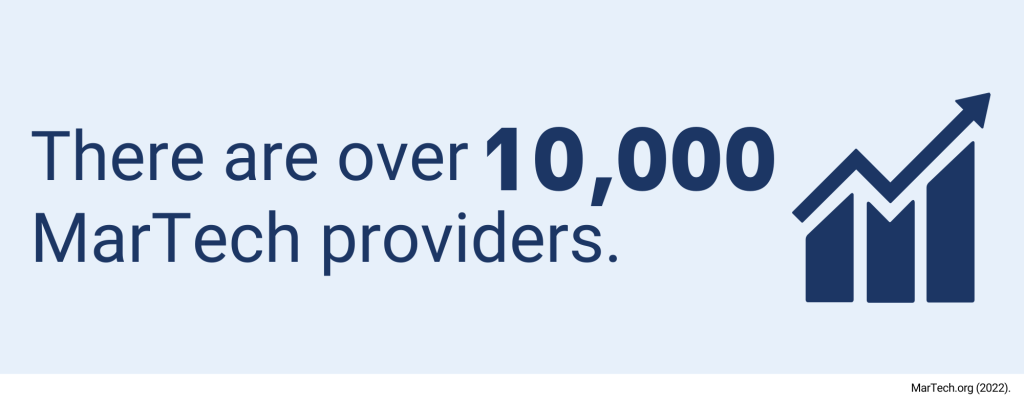Are you getting ready to buy a MarTech solution? Whether a seasoned pro or a first-time buyer, you've come to the right place. We are diving into the reality of buying, implementing, and integrating a new piece of MarTech. We have outlined five key steps to ensure your buying process is smooth and low-pressure.
The biggest challenge in most MarTech buying decisions is simplifying the process. With all the stakeholders involved, all the pieces that have to connect, and budget constraints, it's easy to see why this can be challenging.
We know that the leading barrier to building a successful and lasting martech stack is the complexity of integrating the technologies. Statista.com (2021).
Organizations don't always involve the right people early in the decision-making process. Resulting in gaps and an ill-prepared team and integration.
Software is very nuanced across offerings. New marketers and seasoned pros often struggle to bring the right people to the table at key decision points. Here are the five steps your team needs to follow to be ready to buy and integrate a new piece of software.
Step 1: Complete thorough due diligence
The first step is to figure out what challenge you're trying to solve. Think through the "So What" business result from using a new solution.
- Is it solving a one-time problem or a reoccurring challenge?
- Will it see use outside of your business team/function?
- What is the growth or efficiency goal associated with this purchase?
Whatever the challenge or potential for improvement, document everything you know. Interview everyone on your team to determine the impact these challenges are having. Explore further by meeting with the teams you are supporting. Make sure you speak with the Marketing Ops leader or whoever manages technology for the team. You will need to ensure they are confident in the ability of this solution to integrate into your tech stack.
Once you have organized your case and research, compare solutions. Don't settle on the first or cheapest solution provider that you find. You'll want to ensure they meet your technology, security, and budget requirements.
There are over 10,000 MarTech providers, so it's likely you will have several top contenders to decide between.
Once you have identified 2-3 top solution providers, it is time to reach out to them. Each one will likely have its own sales process, and it is important to mention your requirements early on. This will help their sales team deliver the value and materials you need to meet your procurement requirements.
Step 2: Present your recommendation
Once you've completed your research, create an internal proposal. You will need to craft a professional pitch for internal stakeholders and leadership. This will be your time to share your concerns/interests related to your chosen options. Most leaders will ask for your recommendation during this presentation.
Make sure you include key decision-makers in this proposal.
If you aren't sure who that is, ask your direct manager. A common mistake in a MarTech buying decision is not having a fundamental role included. That can derail the entire proposal or, worse, the integration. Prepare for questions and concerns from leadership. Be prepared with documentation to answer specific questions and provide clarification.
Remember, this will go to a decision-making audience, so be clear and concise. Get to the main points first to ensure you deliver value that resonates with your audience.
Use data as your main points of reference if data isn't available to highlight the impact of this challenge, reference business research, or case studies. Focus on the impact on revenue, risk, or efficiency. All MarTech solutions should address the impact in one or more of these areas. This will prevent doubt around the "WHY" of buying a new solution.
Step 3: Gain executive buy-in
Get buy-in and agreement internally before moving forward with demos or presentations. This will lessen the amount of back and forth with the providers’ sales team. This is less of a concern if you are the primary decision-maker. If you report to a decision-maker, ensure this step is complete before meeting with a solution provider.
You'll want to gain confirmation on the:
- Project scope/product need
- Budget
- Internal support for implementation/integration
- Decision timing.
Trust us; this step will prevent some headaches down the line.
Step 4: Be transparent
Always be completely open and transparent during the internal process and prep. If you need clarification about something, go ahead and ask your team. The odds are you won't be the only one confused, and it will likely come up down the line.
This next part may seem obvious, but it isn't always front of mind. Be honest with the solution provider on the timeline, obstacles, and questions your team has so they can address any points of concern early on or help navigate internal objections. We want this to be a win for everyone, so help the players on the selling side to ensure this process can move on efficiently for both parties.
Step 5: Have patience
Be patient- but persistent- with yourself, leadership, and the solution provider. These decisions can take weeks, sometimes months to complete. Set weekly meetings with your team to discuss it to ensure the process is smooth and doesn't get held up.
Sometimes adding a stakeholder or a business update stalls this process. Check in with your leadership and involved stakeholders to see if there are other areas to clarify in the decision-making process. If you have to take a step back and recalibrate, that's ok.
MarTech decisions don't have to be wearisome or exhausting. Establish a consistent process for researching, buying, and integrating new technology so you won’t be a part of the 46% of decision-makers that said integration was the most significant barrier to success. Use these five steps to guide your role and responsibilities in the process. And remember, a lot of marketers make these decisions every day! Reach out to your network for recommendations and use review sites. Websites like G2 do a great job sorting and lining up options for you. With verified customer reviews, you can take out some of the guesswork.
Best of luck navigating your purchasing decisions!

